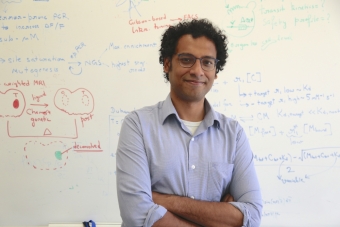
Magnetic resonance imaging (MRI), a technique that uses strong magnetic fields and radio waves to generate images of the organs in the body, is an indispensable method for diagnosing diseases, organ damage, and monitoring the course of treatment. MRI measures the amount and magnetic properties of water in different tissues of the body, mapping the location of the water and then using the information to generate a detailed image. But because only a small fraction of the water molecules contributes to the signal used to create an image, MRI can only be used to look at tens of thousands of cells per voxel, which is essentially a three-dimensional pixel. As a result, MRI is considered an insensitive technique, allowing scientists to study biological functions at a macroscale, but unable to provide insights at the cellular level. UC Santa Barbara chemical engineering and biological engineering assistant professor Arnab Mukherjee has partnered with Mark Sellmyer, an assistant professor of radiology at the University of Pennsylvania, on a project to improve the sensitivity of MRI-based cellular imaging by at least an order of magnitude.
“The overarching goal of our project is to develop an approach that allows small populations of cells, possibly even single cells, to be visualized and followed at any arbitrary depth in a living organism, using MRI,” said Mukherjee.
Their partnership was among ten multidisciplinary research teams selected to receive a combined $1,180,000 in funding as part of the Scialog: Advancing BioImaging Initiative. Now in its second year, Scialog, which is short for “science + dialog,” aims to accelerate the development of next-generation imaging technologies by supporting high-risk, high-reward projects based on innovative ideas. Mukherjee’s project, titled “Improving MRI Detection Limits,” will receive $50,000 in funding from the Chan Zuckerberg Initiative (CZI), which was co-founded in 2015 by Priscilla Chan and Mark Zuckerberg to build a more inclusive, just, and healthy future for everyone.
“This has been one of the most exciting awards for me, both because of the unconventional nature by which these grants are funded, and the unconventional projects they tend to fund,” said Mukherjee, whose previously received a Maximizing Investigators’ Research Award from the National Institutes of Health, a Discovery Award from the Department of Defense, and a NARSAD Young Investigator Award from the Brian & Behavior Research Foundation. “This funding will allow us to initiate early work towards exploring an ambitious idea to look at small numbers of cells in animals with MRI.”
Mukherjee’s research focuses on developing genetically encoded biomolecular reporter proteins to study cell physiology. Reporters are attached to the regulatory sequence of another gene or protein of interest, which allows the function or location of the target to be tracked and monitored. Mukherjee’s lab investigates how unusual biophysical properties, such as water diffusion and paramagnetism, a phenomenon in which some materials are weakly attracted by an externally applied magnetic field, could be engineered to build MRI-visible reporters to study biology in living animals.
This collaboration will combine Mukherjee’s expertise in reporter-gene technology, MRI, and cellular engineering with Sellmyer’s expertise in chemical biology, synthetic gene circuits, and protein degradation technologies to break sensitivity barriers in MRI-based imaging. Mukherjee’s reporter technology genetically manipulates cells to exchange water across the cell membrane at a very fast rate. Building on this reporter, the conceptual basis of their project is to design a mechanism for engineering intercellular communication that allows reporter-generated signals from a small number of cells to spread to nearby cells, thereby amplifying the net signal obtained from a voxel.
“This water diffusion creates signals that can be visualized with the MRI,” Mukherjee explains, adding that their tools are based on water channels called aquaporins, that will make water exchange chemically tunable and capable of affecting a large number of molecules in several cells at once. “Collectively, these capabilities will increase sensitivity by both removing internal background and amplifying signals.”
Their work, ultimately, could allow scientists to monitor genetic activity in double-digit numbers of cells per voxel, potentially even approaching single-cell sensitivity. Because many key biological processes involve small groups of cells — for example, neural activity, infiltration of immune cells in a tumor, and onset of metastatic activity — their work has significant real-world implications.
“This project could potentially shed light on the fundamental biology of disease-relevant processes at the molecular and cellular levels, which could have a direct impact on the development of new therapeutics,” he said.
The Scialog award provides critical seed funding, which is intended to produce preliminary results that the researchers can use to apply for major external funding to expand their research efforts.
“While the initial seed funding is for a one-year project, we envision this to be the beginning of a longer-term, truly cross-cutting scientific adventure,” Mukherjee said.
The twenty-one researchers involved in this year’s ten project represent institutions across the United States and Canada. The Scialog: Advancing BioImaging Initiative is sponsored by the Research Corporation for Science Advancement, CZI, and the Frederick Gardner Cottrell Foundation, with additional support from the Walder Foundation.
“Multidisciplinary collaborations create synergies that spark new ideas,” said RCSA President and CEO Daniel Linzer. “In the same way, funding organizations investing in forward-thinking projects like these can work together to expand the horizons of knowledge.”



